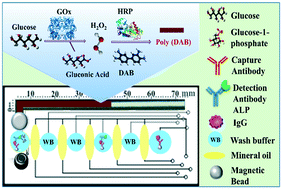Distance-based paper/PMMA integrated ELISA-chip for quantitative detection of immunoglobulin G†
Abstract
The enzyme-linked immunosorbent assay (ELISA) is one of the most commonly implemented clinical diagnostic tools for the detection and quantification of protein biomarkers. However, conventional ELISA tests require sophisticated infrastructure, expensive reagents, long assay time, and expertise for operation, which are not often easily accessible in resource-limited settings. Microfluidic ELISA-chip based point-of-care (POC) testing allows miniaturization and integration of complex functions that facilitate their usage in limited-resource settings. The current work demonstrates a simple, portable, low cost and equipment-free paper/poly(methyl methacrylate) (PMMA) integrated microfluidic ELISA-chip as a POC device with a visual distance-based readout for quantitative detection of clinical biomarkers. The integrated paper/PMMA ELISA-chip utilizes the movement of immunoassay complexes with magnetic beads by a permanent magnet in a PMMA part of the compartment. The target concentration is translated into a visual distance signal readout for quantitative detection of biomarkers in a μPAD. Because it does not require sophisticated instruments and has the added advantages of low cost, easy operation, and disposability with quantitative visual readout, the paper/PMMA ELISA-chip holds great promise for portable detection of target bioanalytes as a POC diagnostic tool in resource-limited setups.



 Please wait while we load your content...
Please wait while we load your content...